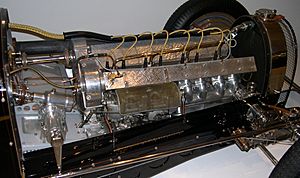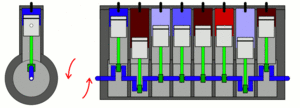Straight-eight engine facts for kids

A straight-eight engine is a type of engine that has eight cylinders. These cylinders are all lined up in a straight row. This is why it's also called an inline-eight engine. All eight cylinders are connected to one long rod called a crankshaft. This engine can run on different kinds of fuel, like gasoline or diesel.
One cool thing about straight-eight engines is that they can be made to run very smoothly. All engines have some shaking or vibration from the crankshaft. To help with this, a special part called a harmonic damper is added to the end of the crankshaft. This part helps to reduce the vibrations. Without it, the engine might get damaged.
Because they ran so smoothly, straight-eight engines were very popular in fancy cars and race cars a long time ago. However, these engines are quite long. This means cars needed a very long space under the hood to fit them. Because of their size, straight-eight engines are not used much in modern cars. They have mostly been replaced by V8 engines, which are shorter and stronger. During World War I, companies like Mercedes and BMW even built straight-eight engines for airplanes. These engines were good for planes because they helped with aerodynamics, meaning the plane could move through the air more easily.
Racing and Performance Cars
The first successful straight-eight racing engine was made by the Duesenberg brothers in 1920. Their engine helped cars finish third, fourth, and sixth in the famous Indianapolis 500 race. The very next year, one of their cars won the French Grand Prix.
From the late 1920s to the mid-1950s, the straight-eight was the top choice for racing car engines. Famous car makers like Bugatti, Duesenberg, Alfa Romeo, Mercedes-Benz, and Miller built amazing race cars. These cars used powerful straight-eight engines during the 1920s and 1930s.
Images for kids
-
The engine from a Duesenberg Model J car.
See also
 In Spanish: Motor de ocho cilindros en línea para niños
In Spanish: Motor de ocho cilindros en línea para niños





